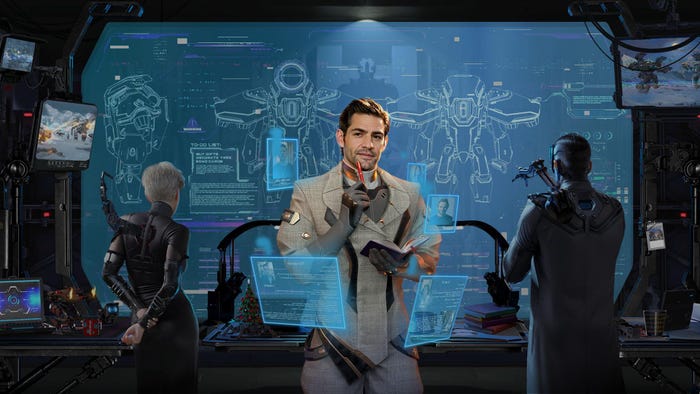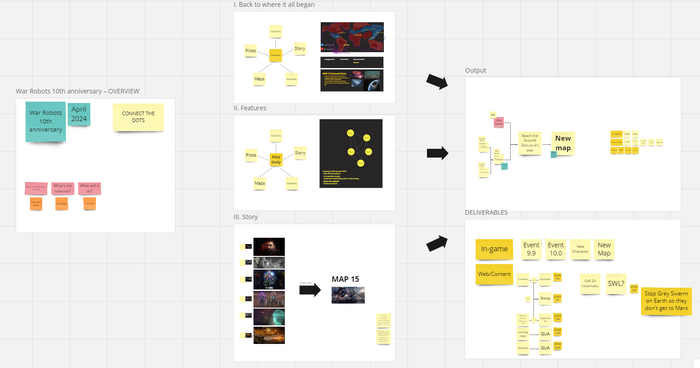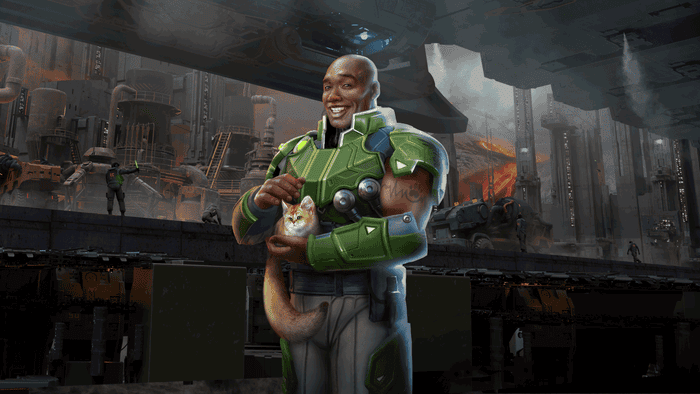
Featured Blog | This community-written post highlights the best of what the game industry has to offer. Read more like it on the Game Developer Blogs.
How to build a narrative in a PvP game: without a narrative designer on the team
Do mobile games really need a narrative? And how can we build one if we don’t have a narrative designer?
March 14, 2024

Do mobile games really need a narrative? And how can we build one if we don’t have a narrative designer? We share how answering this question improved the development of our mobile shooter, War Robots, as well as our experience and tips for creating a narrative without a narrative designer.

Every game designer, producer, or specialist working on mobile games has probably wondered at least once: do mobile games really need a narrative in the first place?
I entered the industry as a narrative designer, then gradually retrained as a game designer, and then, producer. So, naturally, this question concerned me, too. This question was magnified because I work on the midcore shooter War Robots, which had already been in existence without even the slightest bit of a narrative for five years – and obviously hadn’t suffered much for the lack of one.
Then, in 2019, we came up with the “Pilots” feature and decided that pilots, unlike robots, needed a story and a world to live in. This meant we needed to add at least a minimal amount of lore and plot elements to the game. But was this really necessary – and how were we going to do it if there wasn’t a single narrative specialist on the team?
Hi all! I'm Sofya Solomonova, Associate Producer of the War Robots project, which will soon celebrate its 10th anniversary. Up next, I’ll tell you how we at Pixonic (MY.GAMES) built the lore and narrative of the game without the help of narrative designers.
What is a narrative, and is it needed in a mobile PvP game?
First, let's draw one crucial distinction: the difference between a narrative and a plot. When the phrase “game narrative” comes up somewhere, we immediately think about something like the story arc in The Witcher or The Last of Us – or perhaps Homescapes. But this is not always the case: a game can have a narrative, even if there are no dialogues, cutscenes – or any scenes at all. This is because narrative doesn’t equal plot.
Instead, a narrative is a combination of backstory, lore, plot elements, and even visuals – everything that gives players an idea about the world where the action takes place and the role of the characters – as well as how the players themselves fit into things.
War Robots has no central plot; the game is a session PvP shooter, so it would hardly be feasible to create a straightforward narrative. Still, since the end of 2018, we’ve known the world that our characters (both robots and pilots!) live in, how they got there, and where they’re going.
Let me give you a brief outline: War Robots takes place in the near future, in the year 2143, in a universe where people have essentially destroyed the Earth and, thus, were forced to move to Mars. In this world, five major corporations rule the Red Planet, and while they are not formally at odds with each other, in reality, they are waging an endless proxy war with the forces of mercenary armies. They are primarily fighting for the resources of the Earth: years after the Cataclysm, the planet has once again become suitable, if not for life, then at least for the extraction of minerals and technology. Our players assume the role of mercenaries (or rather commanders of small mercenary groups) as they fight each other for fame, money, and resources.
We were able to convey all this information to the players in a variety of ways: the main source of narrative (the storytelling channel) in War Robots is the biographies of pilots. Three small paragraphs tell the story of one specific person. This entry also contains information about the structure of the world, the lives of corporations, politics, economics, and culture.

In addition to this, there are also small narrative inserts in quests and temporary events. However, most of the lore, as well as the stories of individual iconic characters and story arcs, unfolds in the materials that our community department creates. As a point of reference, in the past, we have been inspired by what Riot Games was doing (and who knows, maybe one day we’ll make our own Arcane).
Our first cinematic was dedicated to pilots and was created in-house on a small budget. We had to make do with simple models with basic animations, and the plot was mainly conveyed via voiceover. However, at that time, the video was a real breakthrough and helped us attract player attention to the pilots.
Our first cinematic, made in 2019
Years passed, and in 2023, we released the delightful nine-minute Gray Swarm, full of drama, action, and mystery. Be sure to check it out, as it has a charismatic heroine who also occupies an important spot in the WR universe.
But that’s not all: in addition to full-fledged 3D cinematics, we also made several short cartoons in a comic-book style and even an audio drama (radio play) Plan B. All this can be found on the project’s YouTube channel. Soon, we will release our new video dedicated to the apotheosis of the story about Gray Swarm, which we have been developing for several years. This cinematic is dedicated to the 10th anniversary of the project and will embody the spirit of our game and why players all around the world love it.
Again, why bother? In the case of cinematics, our goal is simple and as practical as possible: organic traffic. If a video turns out to be interesting and good enough for YouTube algorithms to pick it up and recommend it to users, we will attract a new audience and players. That works not only for War Robots itself but also for any other War Robots Universe games (more on that later).
The Grey Swarm cinematic, made in 2023
But, if we step back from cold numbers, the narrative has another critical function. (Yes, yes, even in a PvP shooter!) Perhaps the most valuable result we got when we started adding narrative to the game was a holistic world – lore helps us create the designs of our robots and more. We now know that they can be produced by one of five factions and that each faction has its own features and style. For example, all the robots of the paramilitary corporation DSC are powerful fighting machines with angular, rough shapes and a military style. Meanwhile, Icarus, which focuses on breakthrough technologies, prefers a more elegant, thin, high-tech design. With our defined world, we get content that, while remaining unique, has recognizable features and creates stylistic uniformity.
This also works in the opposite direction, and the world of War Robots itself serves as inspiration. “What if...?” questions give rise to many ideas for new mechanics, visual techniques, and funny Easter eggs. In other words, lore begets more lore.
Further, our established narrative helps when planning themed events. For example, we cannot just make a Halloween event but go deeper, say something related to an explosion in a laboratory specializing in biotechnology at EvoLife! This is especially important when a game is almost ten years old, and all the options for “a Halloween event” have long been exhausted – and, frankly speaking, got boring.
The lore also finds its way into our marketing creatives. For example, our team actively uses clips from cinematics as promotional videos. And last year, we supported Pride Month on Google Play by launching live-ops cards with our female pilots, which received a good response. Would we be able to do something like this if we didn't know that these two women were a couple in the story? Of course not!

And finally, let’s talk about the IP, the War Robots Universe I previously mentioned. The PC/Console shooter War Robots: Frontiers, which will be released in Open Beta this year, is not only based on the very lore that we created with the release of the pilots – it develops it further. Thanks to the narrative, we have ended up with two games that are not so similar to each other, yet nonetheless maintain a strong connection. Further, we get the chance, for example, to send a guest star to the Frontiers (yes, we're talking about you, APPM-3TR).
DIY narrative
Let's now return to the question I raised at the very beginning of the article. We want narrative. How do we create one without a single narrative designer in the studio? Well, we have a super-professional teams of game designers and community managers who are ready to try on several different hats. It is their efforts, as well as those of a small group of enthusiasts, who make up the narrative core of the team (we call them the Storytelling Illuminati). These are the folks who are moving the War Robots universe forward.
In the core team, there are only five of us (and yes, I’m one of them): a producer, a lead CM, two game designers, and a concept artist. All strategic decisions on the narrative are made by these “Illuminati”.
Together, we decide where the history of our world will go, come up with ideas for new videos, and maintain a narrative bible for the project (or try to). We work via weekly meetings where we discuss current issues or pitch ideas; to accomplish our task, we have a monstrous Miro board, which serves both as a place for collecting information and as a space for brainstorms.

This information is then sent to external contractors who produce cinematics, or to our GD team.
The tasks of the GD include transforming global narrative ideas into what our players will see: the design of robots, the appearance and biographies of pilots, and the design of events (you can read more about that here).
As not all GDs are innate writers, we streamline the process of working on the narrative and impose strict requirements. For example, for pilot biographies, there are clear guidelines for the number of characters and duration of work (no more than two days per biography!). Pilot stories should be as concise as possible but have clear structure and appealing emotional hooks. Each character must be unique not only in appearance but also in terms of the narrative. To ensure all these conditions are met, all pilot texts must be reviewed by a GD with good storytelling skills. As a rule, this is one of the participants in our circle of storytelling Illuminati, or a GD who has shown themselves to be great at narrative tasks.
Our art team follows a similar approach. They have a style guide and an idea of what robots or pilots of each faction should look like, what elements characterize corporations, and what should be avoided. This allows our content to be both unique and consistent.
Of course, the results of the work of both the GD and the artists are reviewed by that very narrative core team to make sure that everything corresponds to our ideas about the lore of the game.
There is one more important thing to point out here. At first, we tried to strictly police that everything in our world was synchronized and asked questions like “Are there cats on our Mars?” This was when we faced several nuances. First, we have very few narrative resources. And secondly, players in games like ours don't pay that much attention to narrative elements. So, we began to approach the process more simply: now, any tiny and insignificant elements in the overall picture of the War Robots world are left to the particular piece’s author. Do you want your character to have a pet cat? Go ahead.

But we still keep track of some details, and they become funny Easter eggs for us and the players. For example, the pilots in the War Robots world are very fond of the Mjolnir Time energy drink. This drink appears in our texts, videos, and ads for it can even be found on one of the maps. At the same time, the drink has its history: who made it, and why it looks the way it does. All the little touches like these make the War Robots universe a little more alive.
***
Narrative is not a critical element for a PvP game, but it can definitely come in handy – and you don’t even need to hire a dedicated narrative designer for your team.
Let’s try to summarize our experience with War Robots:
If a studio doesn’t have a narrative designer or plans to hire one, this doesn’t mean that it will be impossible to build a narrative in the game. Gather your creative leads — GDs, art, producers — and use their skills to form an idea of your game’s universe, your story goals, and how the lore and narrative will help you.
Start small. You don’t have to immediately look for expensive contractors to make huge cinematics. Try to make something simple using game models, come up with a comic book, add text blocks with lore to the game, or at least start with a post on the site.
Set clear restrictions and deadlines: this will help fight graphomania. And let everyone know that someone else will carry out the final check of all the material.
Think through the basic logic of the world, but don’t get too caught up in the small details – leave those to the folks who will write individual stories. (After all, maybe there really are cats on Martian bases?)
Read more about:
Featured BlogsAbout the Author(s)
You May Also Like









